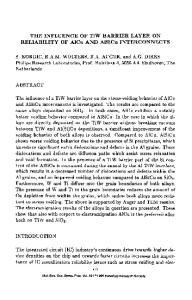The Influence of Device Structure on High-electric-field Effects and Reliability of AlGaN/GaN HFETs
- PDF / 374,118 Bytes
- 6 Pages / 612 x 792 pts (letter) Page_size
- 14 Downloads / 386 Views
0955-I14-01
The Influence of Device Structure on High-electric-field Effects and Reliability of AlGaN/GaN HFETs Weiwei Kuang, Robert J Trew, Griff L Bilbro, and Yueying Liu Electrical and Computer Engineering, North Carolina State University, Raleigh, NC, 27695
ABSTRACT AlGaN/GaN HFETs have demonstrated excellent RF performance, but the devices still suffer from a reliability problem. The decrease of the dc current and RF output power over time is attributed to gate tunneling which is determined by the magnitude of electric field at the gate edge. In this work, in order to improve the reliability of AlGaN/GaN HFETs, a 2D drift-diffusion simulation tool is used to explore the relationship between the magnitude of electric field and different device structures through modifications of the 2DEG sheet charge density, AlGaN barrier layer thickness, AlGaN doping concentration and gate to drain spacing. The effect of field plates is also investigated. It was found that decreasing 2DEG sheet charge density results in much improved reliability, although the current and output power are somewhat reduced. INTRODUCTION The excellent RF performance demonstrated in AlGaN/GaN HFETs results from the combination of high current density with high voltage operation, which benefits from the high sheet charge density in these hetero-structures, the high carrier mobility in the channel and the high breakdown voltage inherent in the GaN material. These devices are of particular interests because of their advantages on high power density applications, and more than 32 W/mm output power at 4 GHz [1], and 10 W/mm at 40 GHz [2] have already been reported. But the performance of AlGaN/GaN HFETs was found to be limited from the highinjection and high-field nonlinearities. There are three fundamental physical effects occurring during high-current and high-voltage operation conditions: 1) space charge effects in the gatesource region under high current injection [3], 2) high field breakdown effects at the edge of the gate electrode and also in the conducting channel [4], and 3) electron leakage from the gate to the surface of the semiconductor [5]. Among them, the electron leakage problem at high-field conditions makes the devices suffer from a reliability problem where the dc current and RF output power decrease over time. This gate tunneling current is determined by the magnitude of electric field at the gate edge, and can be minimized by optimizing the device structure. 2D driftdiffusion simulations have been used to investigate the high-electric-field effects in AlGaN/GaN HFETs: Field plate geometry and material variables were optimized by Karmalkar et al. [6] and Saito et al. [7] in order to achieve maximum breakdown voltage and better frequency response. In this work, In order to improve the reliability of AlGaN/GaN HFETs, 2DEG sheet charge density, gate to drain spacing, AlGaN barrier layer thickness and doping concentration are modified to explore the possible method to suppress the electron leakage. The effect of field plates is also i
Data Loading...











